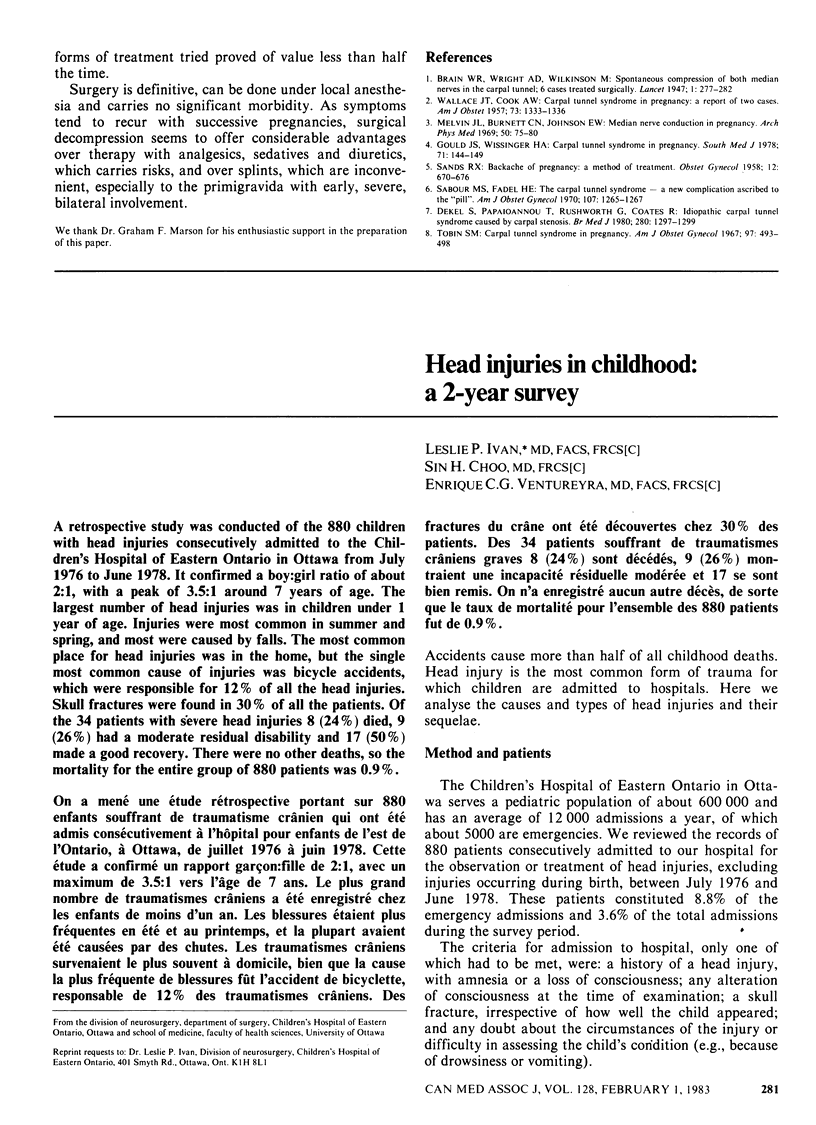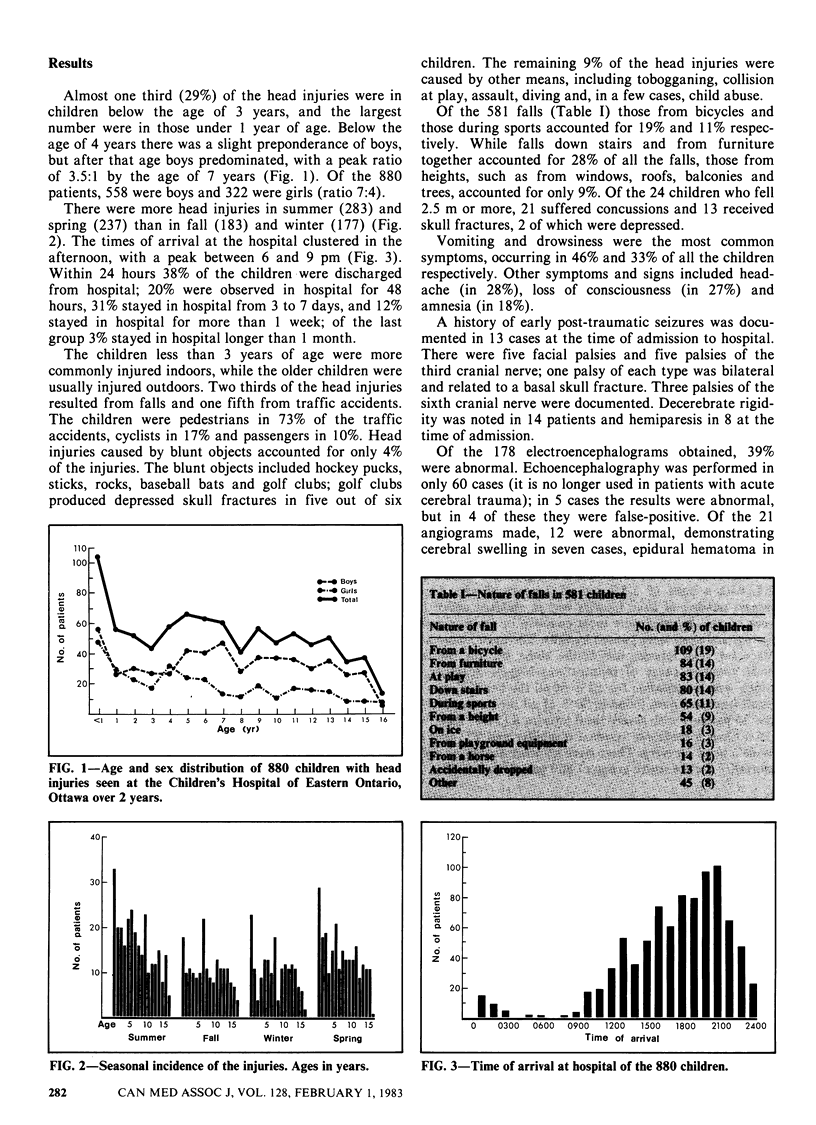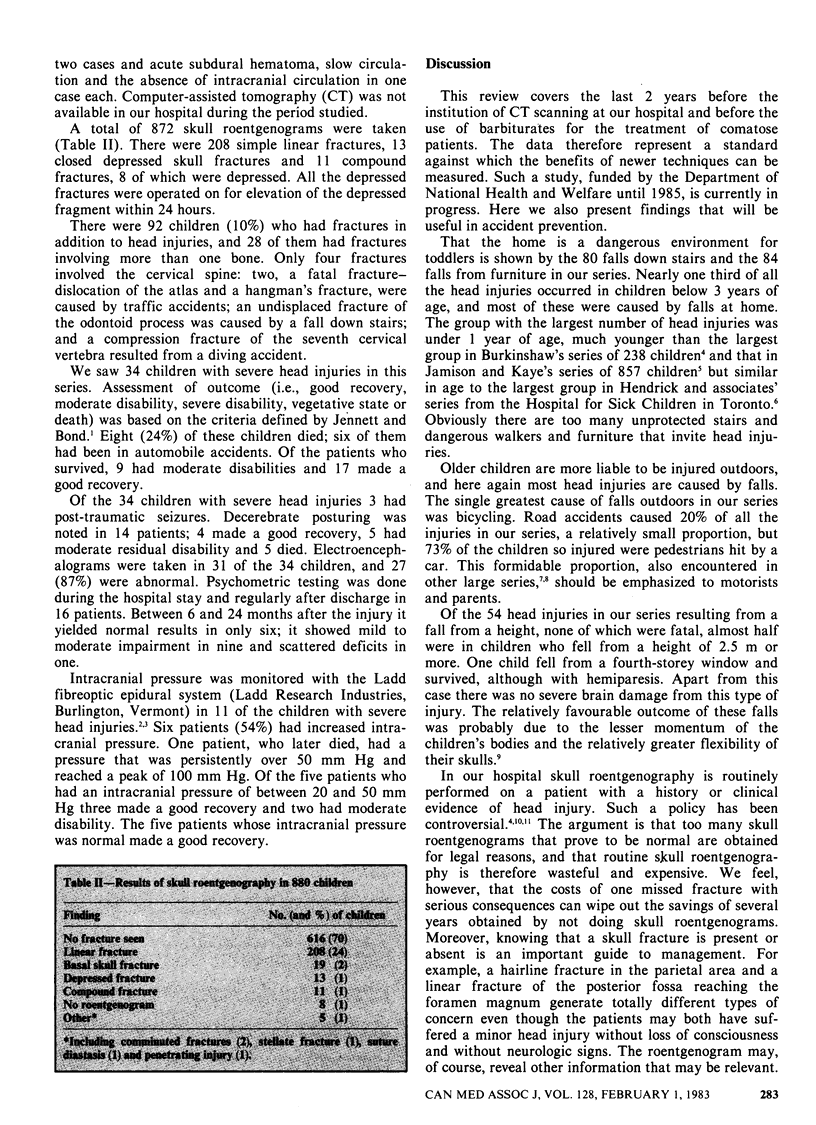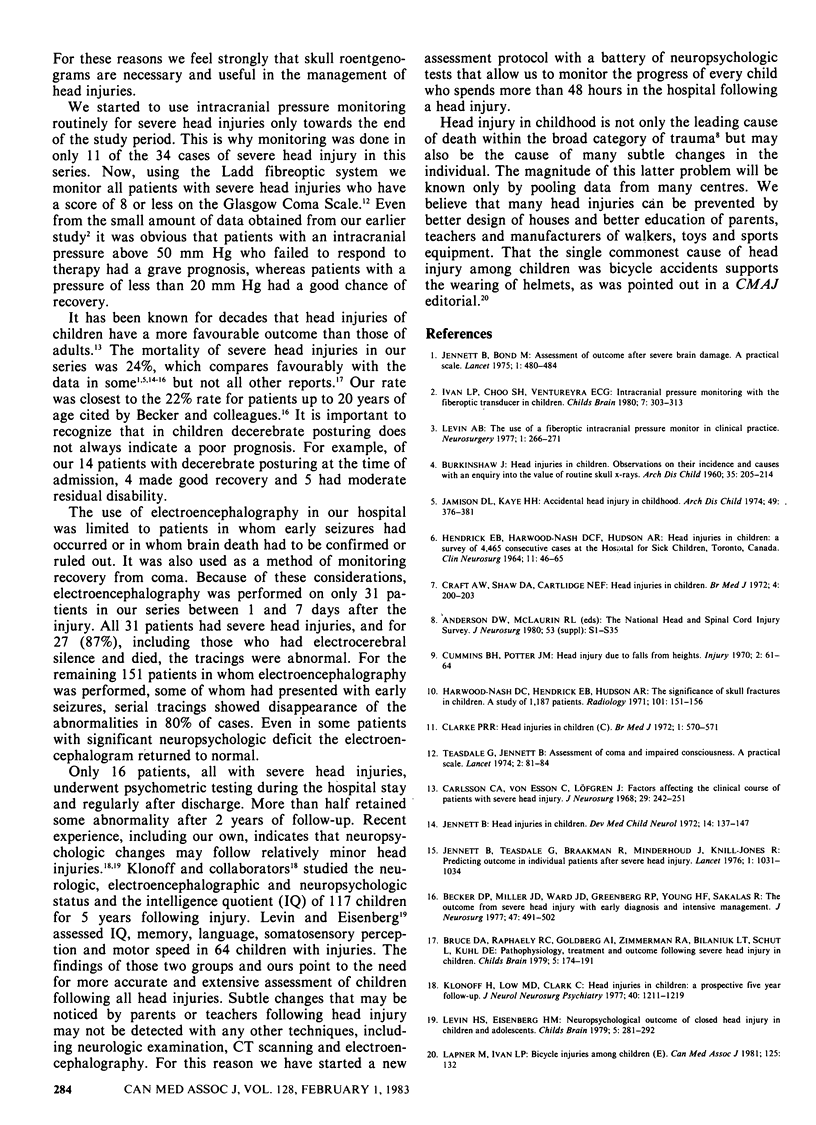Abstract
A retrospective study was conducted of the 880 children with head injuries consecutively admitted to the Children's Hospital of Eastern Ontario in Ottawa from July 1976 to June 1978. It confirmed a boy:girl ratio of about 2:1, with a peak of 3.5:1 around 7 years of age. The largest number of head injuries was in children under 1 year of age. Injuries were most common in summer and spring, and most were caused by falls. The most common place for head injuries was in the home, but the single most common cause of injuries was bicycle accidents, which were responsible for 12% of all the head injuries. Skull fractures were found in 30% of all the patients. Of the 34 patients with severe head injuries 8 (24%) died, 9 (26%) had a moderate residual disability and 17 (50%) made a good recovery. There were no other deaths, so the mortality for the entire group of 880 patients was 0.9%.
Full text
PDF



Selected References
These references are in PubMed. This may not be the complete list of references from this article.
- BURKINSHAW J. Head injuries in children. Observations on their incidence and causes with an enquiry into the value of routine skull x-rays. Arch Dis Child. 1960 Jun;35:205–214. doi: 10.1136/adc.35.181.205. [DOI] [PMC free article] [PubMed] [Google Scholar]
- Becker D. P., Miller J. D., Ward J. D., Greenberg R. P., Young H. F., Sakalas R. The outcome from severe head injury with early diagnosis and intensive management. J Neurosurg. 1977 Oct;47(4):491–502. doi: 10.3171/jns.1977.47.4.0491. [DOI] [PubMed] [Google Scholar]
- Bruce D. A., Raphaely R. C., Goldberg A. I., Zimmerman R. A., Bilaniuk L. T., Schut L., Kuhl D. E. Pathophysiology, treatment and outcome following severe head injury in children. Childs Brain. 1979;5(3):174–191. doi: 10.1159/000119817. [DOI] [PubMed] [Google Scholar]
- Carlsson C. A., von Essen C., Löfgren J. Factors affecting the clinical corse of patients with severe head injuries. 1. Influence of biological factors. 2. Significance of posttraumatic coma. J Neurosurg. 1968 Sep;29(3):242–251. doi: 10.3171/jns.1968.29.3.0242. [DOI] [PubMed] [Google Scholar]
- Clarke P. R. Head injuries in children. Br Med J. 1972 Feb 26;1(5799):570–571. doi: 10.1136/bmj.1.5799.570-b. [DOI] [PMC free article] [PubMed] [Google Scholar]
- Craft A. W., Shaw D. A., Cartlidge N. E. Head injuries in children. Br Med J. 1972 Oct 28;4(5834):200–203. doi: 10.1136/bmj.4.5834.200. [DOI] [PMC free article] [PubMed] [Google Scholar]
- Cummins B. H., Potter J. M. Head injury due to falls from heights. Injury. 1970 Jul;2(1):61–64. doi: 10.1016/s0020-1383(70)80120-6. [DOI] [PubMed] [Google Scholar]
- Harwood-Nash D. C., Hendrick E. B., Hudson A. R. The significance of skull fractures in children. A study of 1,187 patients. Radiology. 1971 Oct;101(1):151–156. doi: 10.1148/101.1.151. [DOI] [PubMed] [Google Scholar]
- Hendrick E. B., Harwood-Hash D. C., Hudson A. R. Head injuries in children: a survey of 4465 consecutive cases at the hospital for sick children, Toronto, Canada. Clin Neurosurg. 1964;11:46–65. doi: 10.1093/neurosurgery/11.cn_suppl_1.46. [DOI] [PubMed] [Google Scholar]
- Ivan L. P., Choo S. H., Ventureyra E. C. Intracranial pressure monitoring with the fiberoptic transducer in children. Childs Brain. 1980;7(6):303–313. doi: 10.1159/000119958. [DOI] [PubMed] [Google Scholar]
- Jamison D. L., Kaye H. H. Accidental head injury in childhood. Arch Dis Child. 1974 May;49(5):376–381. doi: 10.1136/adc.49.5.376. [DOI] [PMC free article] [PubMed] [Google Scholar]
- Jennett B., Bond M. Assessment of outcome after severe brain damage. Lancet. 1975 Mar 1;1(7905):480–484. doi: 10.1016/s0140-6736(75)92830-5. [DOI] [PubMed] [Google Scholar]
- Jennett B. Head injuries in children. Dev Med Child Neurol. 1972 Apr;14(2):137–147. doi: 10.1111/j.1469-8749.1972.tb02571.x. [DOI] [PubMed] [Google Scholar]
- Jennett B., Teasdale G., Braakman R., Minderhoud J., Knill-Jones R. Predicting outcome in individual patients after severe head injury. Lancet. 1976 May 15;1(7968):1031–1034. doi: 10.1016/s0140-6736(76)92215-7. [DOI] [PubMed] [Google Scholar]
- Klonoff H., Low M. D., Clark C. Head injuries in children: a prospective five year follow-up. J Neurol Neurosurg Psychiatry. 1977 Dec;40(12):1211–1219. doi: 10.1136/jnnp.40.12.1211. [DOI] [PMC free article] [PubMed] [Google Scholar]
- Lapner M., Ivan L. P. Bicycle injuries among children. Can Med Assoc J. 1981 Jul 15;125(2):132–132. [PMC free article] [PubMed] [Google Scholar]
- Levin A. B. The use of a fiberoptic intracranial pressure monitor in clinical practice. Neurosurgery. 1977 Nov-Dec;1(3):266–271. doi: 10.1227/00006123-197711000-00008. [DOI] [PubMed] [Google Scholar]
- Levin H. S., Eisenberg H. M. Neuropsychological outcome of closed head injury in children and adolescents. Childs Brain. 1979;5(3):281–292. doi: 10.1159/000119825. [DOI] [PubMed] [Google Scholar]
- Teasdale G., Jennett B. Assessment of coma and impaired consciousness. A practical scale. Lancet. 1974 Jul 13;2(7872):81–84. doi: 10.1016/s0140-6736(74)91639-0. [DOI] [PubMed] [Google Scholar]


